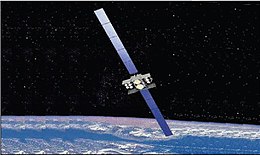USA-243
 Artist's impression of a WGS satellite in orbit | |
| Mission type | Communications |
|---|---|
| Operator | US Air Force |
| COSPAR ID | 2013-024A |
| SATCAT no. | 39168 |
| Mission duration | 14 years (planned)[1] |
| Spacecraft properties | |
| Spacecraft type | WGS Block II |
| Bus | BSS-702HP |
| Manufacturer | Boeing |
| Launch mass | 5,987 kilograms (13,199 lb)[2] |
| Power | 11 kW[1] |
| Start of mission | |
| Launch date | 25 May 2013, 00:27 UTC |
| Rocket | Delta IV-M+(5,4) D362 |
| Launch site | Cape Canaveral SLC-37B |
| Contractor | ULA |
| Orbital parameters | |
| Reference system | Geocentric |
| Regime | Geostationary (planned) |
| Transponders | |
| Band | X and Ka band |
| Frequency | 7.2/8.4 GHz (Military X-Band) 30/20 GHz (Military Ka-Band) |
USA-243, also known as WGS-5, is an American military communications satellite. It was the fifth satellite to be launched as part of the Wideband Global SATCOM program,[3] and the second Block II spacecraft.[4]
Constructed by Boeing, USA-243 is based on the BSS-702HP satellite bus. It had a mass at liftoff of 5,987 kilograms (13,199 lb),[2] and a design life of 14 years.[1] Its two solar panels generate upwards of 11 kilowatts of power.[1] The spacecraft is equipped with X and Ka-band transponders. An R-4D bipropellant rocket motor and four XIPS-25 ion engines provide propulsion.[5]
USA-243 was launched by United Launch Alliance. A Delta IV-M+(5,4) rocket, Delta 362, was used to place it into a supersynchronous transfer orbit, from which the spacecraft will be maneuvered into geostationary orbit.[5] It was launched from Space Launch Complex 37B at the Cape Canaveral Air Force Station at 00:27 UTC on 25 May 2013. A launch attempt 24 hours before was cancelled because of a problem with a helium pressurization line.[4] The launch was successful.[6]
References
- ^ a b c d Krebs, Gunter. "WGS 1, 2, 3, 4, 5, 6, 7, 8, 9". Gunter's Spage Page. Retrieved 25 May 2013.
- ^ a b "WGS-5 Delta IV Mission Overview" (PDF). United Launch Alliance. Archived from the original (PDF) on 16 September 2013. Retrieved 25 May 2013.
{{cite web}}: Unknown parameter|deadurl=ignored (|url-status=suggested) (help) - ^ "Communications satellite launched into space". NBC News. 24 May 2013. Retrieved 25 May 2013.
- ^ a b "Delta IV rocket launches from Cape Canaveral". Central Florida News 13. 24 May 2013. Retrieved 25 May 2013.
- ^ a b Graham, William (24 May 2013). "ULA Delta IV successfully lofts WGS-5 satellite". NASASpaceflight.com. Retrieved 25 May 2013.
- ^ Ray, Justin (25 May 2013). "Delta Mission Report - Mission Status Center". Spaceflight Now. Retrieved 25 May 2013.
